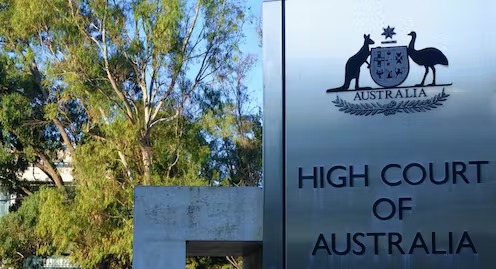While Labor resists calls to change Australia’s system of negative gearing and the Greens push for changes, there’s a chance change could come from somewhere else altogether – Australia’s legal system.
As surprising as it might seem, the legal precedent that allows one million Australians to negatively gear investment properties can be challenged.
That challenge could come from Tax Office, which in my view could launch a test case to clarify what at the moment is a pretty wobbly foundation.
Negative gearing is what happens when an investor (usually a property investor) makes a loss on the investment (usually by paying out more in interest and other costs they receive in rent) and then uses that loss to reduce their salary or wage for taxation purposes in order to pay less tax.
Much of its apparent legality relies on a 1987 Federal Court ruling in a case brought by the Tax Office against a family trust controlled by a Victorian surgeon.
In saying that it is open to challenge, I acknowledge that negative gearing as practiced has been regarded as legal for some time, and that the Tax Office issued a binding ruling saying so in 1995.
I’ll explain why I think the precedent is ripe for a challenge, and then discuss the political and other difficulties the Tax Office would face in mounting such a challenge – difficulties I think could be overcome.
The problematic precedent
The legality of negative gearing for income tax purposes currently rests on the interpretation of the general deduction section of the Income Tax Act, as well as the fact that the so-called loss quarantining rules that specifically prohibit negative gearing apply only to small marginal businesses.
The general deduction section allows taxpayers to deduct from assessable income any loss or outgoing to the extent that “it is incurred in gaining or producing your assessable income”.
This means that losses unrelated to the pursuit of an income can’t be deducted.
Where such expenses are only partly related to gaining income, the section allows that part of them be deducted, with the rest not.
The 1987 case used to establish that losses on rental properties can be used to reduce wages and salaries for tax purposes is known as Commissioner of Taxation versus Janmor Nominees.
How Janmor Nominees played out
The case related to a residential property purchased by a family trust with a large borrowing, in circumstances where the trust rented the property to the controller of the trust (a surgeon) for his family to live in.
In court, the Tax Office argued that the loss shouldn’t be allowed as a deduction because the property wasn’t really rented out. The “rent” was just a familial contribution to costs.
The Tax Office made other arguments as well, among them that the interest expense was private or domestic because the trust was just a mechanism to provide the surgeon and his family with a home to live in.
Naturally, the court’s focus was directed at responding to the Tax Office’s arguments. It held that the rent was a market rent and allowed the deduction.
This meant it didn’t deal with the more important question of whether negative gearing losses were incurred in gaining or producing assessable income.
Losses need to be in pursuit of income
My respectful opinion is that the judgment can’t govern negative gearing as it is usually practiced today, and for that matter, could not have governed it as it was usually practiced back in 1987.
In the standard negative gearing situation, the taxpayer who incurs a rental loss after deducting rental expenses is seeking three things:
-
rent
-
capital growth for the purpose of making a profit
-
use of the loss to reduce other taxable income to reduce tax owed.
In other words, the advantage sought is not limited to the rent.
The first of the three advantages (to obtain rent) satisfies the deduction test – it is connected to the pursuit of an income. The second and third do not.
Regardless of purpose, the courts have held that, to be deductible, expenses need to be objectively “incidental and relevant” to earning income.
Again – objectively – interest expenses are only partly directed at obtaining rent; they are also directed at obtaining tax deductions and capital growth.
After all, who would spend money in order to obtain a smaller amount of money unless some other advantage was being pursued?
That means interest expenses ought to be separated into their deductible (negatively-gearable) and non-deductible portions.
The problem is there seems not to have been a case that considered and decided on these questions. Janmor didn’t, and I know of no other case that did.
The Tax Office ought to seek a ruling
If the Tax Office wanted to be certain about whether negative gearing is legal as it is presently practiced, it could bring a test case in an attempt to obtain a definitive judgment.
It would need to convince a majority of the Full Federal Court (which comprises three or five judges), and perhaps the High Court.
It would face considerable challenges. The first has little or nothing to do with the law; it is political. The Tax Office would get complaints.
Politicians may even accuse the Tax Office of stepping into politics, but this would be a baseless claim because all it would be doing is testing the scope of the law.
The Tax Office regularly tests the boundaries of deduction provisions by bringing cases to the courts, even where political sensitivities are involved.
Tax advisers might also complain. Their criticism would be along the lines of “why didn’t you bring this earlier”?
It is a criticism to which the Tax Office might not have a ready answer.



 Harvard Professors Sue Trump Administration Over $9B Federal Grant Crackdown
Harvard Professors Sue Trump Administration Over $9B Federal Grant Crackdown  Judge Blocks Trump-Era Funding Freeze Over Maine’s Transgender Sports Policy
Judge Blocks Trump-Era Funding Freeze Over Maine’s Transgender Sports Policy  Yes, government influences wages – but not just in the way you might think
Yes, government influences wages – but not just in the way you might think  Judge Rules Trump Administration Illegally Blocked FEMA Grant Funding
Judge Rules Trump Administration Illegally Blocked FEMA Grant Funding  Japan Orders Google to Halt Anticompetitive Smartphone Practices
Japan Orders Google to Halt Anticompetitive Smartphone Practices  Former OpenAI Employees Back Elon Musk in Lawsuit Over Nonprofit Mission
Former OpenAI Employees Back Elon Musk in Lawsuit Over Nonprofit Mission  What the spiralling trade war means for relations between the US and China
What the spiralling trade war means for relations between the US and China  U.S. Judge Orders Return of Wrongfully Deported Salvadoran Migrant
U.S. Judge Orders Return of Wrongfully Deported Salvadoran Migrant  Fill-in-the-blank training primes AI to interpret health data from smartwatches and fitness trackers
Fill-in-the-blank training primes AI to interpret health data from smartwatches and fitness trackers  South Korea’s Yoon Suk Yeol Removed from Presidency Over Martial Law Scandal
South Korea’s Yoon Suk Yeol Removed from Presidency Over Martial Law Scandal  Conservative Legal Group Challenges Trump’s New China Tariffs in Federal Court
Conservative Legal Group Challenges Trump’s New China Tariffs in Federal Court  California Rejects Musk’s Lawsuit Support Against OpenAI Over Nonprofit Control
California Rejects Musk’s Lawsuit Support Against OpenAI Over Nonprofit Control  OpenAI Sues Elon Musk Over Alleged Harassment and Takeover Attempt
OpenAI Sues Elon Musk Over Alleged Harassment and Takeover Attempt  Gold Soars to New All-Time High Amid Safe-Haven Demand
Gold Soars to New All-Time High Amid Safe-Haven Demand 































